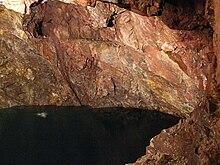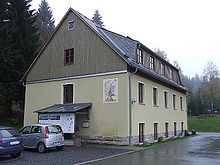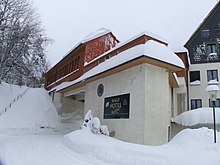Tannenberg mine
| Tannenberg tin ore mine | |||
|---|---|---|---|
| General information about the mine | |||
| other names | Tannenberg mine, Mühlleithen mine | ||
| Information about the mining company | |||
| Operating company | Sachsenz Bergwerks GmbH, VEB Wolfram-Zinnerz Pechtelsgrün | ||
| Start of operation | (Deposit periodically from 1506), 1936 | ||
| End of operation | 1964 | ||
| Successor use | Visitor mine since 1996 | ||
| Funded raw materials | |||
| Degradation of | tin | ||
| tin | |||
| Greisen I | |||
| Mightiness | 60 m | ||
| Greatest depth | 160 m | ||
| Greisen II | |||
| Greatest depth | 160 m | ||
| Geographical location | |||
| Coordinates | 50 ° 24 '56.3 " N , 12 ° 27' 35.8" E | ||
|
|||
| Location | Schneckenstein , Mühlleithen | ||
| local community | Muldenhammer , Klingenthal | ||
| District ( NUTS3 ) | Vogtland district | ||
| country | Free State of Saxony | ||
| Country | Germany | ||
| District | Schneckenstein area | ||
The Tannenberg mine is a former tin mine in the Saxon Vogtland . The tunnel is located south of Tannenbergsthal in the Schneckenstein district and is now used as a visitor mine .
geology
The Tannenberg deposit is located on the western edge of the Eibenstock granite pluton , which broke through Cambrian phyllite layers and changed them with contact metamorphosis . Mined foxed or tubular metagranitische were two old man body in granite , but which lie with their western edge directly on the slate contact and located in the dip move into the depth of granite. The granite-schist contact zone is in Tannenberg Tolln, about 150 meters from the entrance hole away, open-minded .
history
Historic mining
As early as the end of the 15th century, tin ore was being mined in the upper forest area of the Vogtland. In 1506 in the area around Gottesberg a tin mine was called Alter Tannenberg on the Tannenberg morning walk . After the soap mining, the tin ore began to be extracted in the open pit. A remnant of this is the Tannenberg Pinge. Then the mining shifted underground. A hammer mill was built in Tannenbergsthal in 1550 , which was later expanded to include a tin smelter for smelting tin and iron ore. Mining in the entire area around Gottesberg and the Schneckenstein was subject to strong fluctuations, and the operating periods often only lasted a few years. In 1780, the Alter Tannenberg and Alter Schieferbergschacht were named two pits with a precise reference to the deposit.
Mining until 1945
In March 1917, the union Saxonia Bavaria in was Geyer the pit Tannenberg newly granted . From October 1918, the Studiengesellschaft für Bergbau- und Hüttenbetrieb mbH in Berlin operated the Tannenberg mine on behalf of Saxonia Bavaria. From February 1919, the study society assumed the Tannenberg Unified Field mine . In 1919 9 people were employed in the Tannenberg mine . The mining rights of the Tannenberg Vereinigt Feld mine were revoked in August 1921 and the mine was cleared in January 1922. The worm Steiner Zwitterzug and the pit Tannenberg were since 1920 the deadlines and were discontinued at the end 1,922th A mining operation was not started in the aforementioned pits.
On September 22nd, the Neue Sächsische Erzbergbau-Aktiengesellschaft was founded with headquarters in Leipzig , from 1924 in Aue , with a share capital of 3,000,000 marks. The company was a subsidiary of the mining group Georg von Giesches heirs . The aim was to develop tin mining in the Ore Mountains and Vogtland. In addition to other mines, the company was awarded the Winselburg and Osterlamm Vereinigt Feld mine in May 1924 and the Schneckensteiner Zwitterzug in April 1925 . In October 1925, the company acquired the Tannenberg mine field as part of a foreclosure auction.
In 1927 a research program was started on behalf of the company. The old heaps and ping trains were examined, the Comun or Tranksteuer Stolln , the Friedrich-August-Stolln and the Drei-Brüder-Stolln were dealt with and two core drillings were drilled. The investigations did not lead to any new findings regarding the tin prospect in the area. The Winselburg and Osterlamm Vereinigt Feld mine fields and the Schneckensteiner Zwitterzug were then canceled in March 1928.
On March 21, 1929, the company was renamed Sächsisch-Böhmische Zinnbergbau Aktiengesellschaft from 1922 to Bad Elster . The company was based in Bad Elster from 1930 and Plauen from 1933 .
The Schneckensteiner Zwitterzug was awarded to the Saxon State in January 1929.
After obvious bad investments in the Gottesberg-Weidmansheil-Vereinigt-Feld mine owned by the company, the company ran into financial difficulties. This led to the garnishment and the opening of bankruptcy proceedings in 1933 . Despite protests and submission of new funding to the Ministry of Finance, the company's mining rights were revoked in August 1934 and the mine cleared in July 1936. Here, too, no mining operations were started between 1924 and 1935.
On September 1, 1934, prices on the German metal market were decoupled from the world market. In the spirit of the German Reich's striving for self-sufficiency, the President of the Reichsbank, Horace Greeley Hjalmar Schacht, granted price security for metals such as bismuth , cobalt , tin and tungsten . The difference between the production costs and the world market price was paid in the form of subsidies.
In 1935, the deposits Research Unit took the mining authority Freiberg on their work in the area. Among other things, the old masses of the Große Tannenbergspinge near Winselburg were examined.
In August 1936, the Tannenberg mine was awarded to the Saxon state under the name Tannenberg near Klingenthal . In December 1936, operations began under operations manager Ernst Meyer from Lauterbach . In order to approach the Pingen on the Kielberg and examine it, the mining company Wilhelm Kübler from Zwickau cleared the Comun or Tranksteuerstollen , opened it further and drove four crosscuts to the east . On August 1, 1937, the mine was taken over by the Sachsenz Bergwerksgesellschaft mbH and Wilhelm Schievelbusch was appointed operations manager from 1938. Greisen I was approached in 1938 when driving the tunnel . This is accessible above ground through the large Tannenberg Pinge. In 1939, a blind shaft was dug on the bottom of the tunnel at 835.90 m above sea level to open up the deposit . The clear cross-section of the shaft disk is 8.50 m². The shaft reached a depth of 89.40 meters. Three levels were attached at 805.00 m, 775.00 m and 745.00 m above sea level. In 1940, construction of the processing plant began at the mouth of the Tannenberg tunnel , the former Comun or drink tax tunnel . On October 1, 1941, regular dismantling began in Greisen I. Rammelsberger Fließbau was chosen as the dismantling method. The 4834 t of ore extracted up to that point came from the alignment drifts . In 1941 the production was 1439 tons of ore. The workforce increased from 10 people in 1937 to 60 people in 1941. The concentrate obtained was processed in the rolling plant in Freiberg and melted in the Muldenhütten smelter.
Between 1941 and 1943, attempts to extract Topas concentrate were carried out in the Tannenberg processing plant. The concentrate was to be used as a flux in aluminum electrolysis at the Bitterfeld aluminum plant.
On September 22, 1944, the Sachsenz Bergwerksgesellschaft mbH was merged with four other state-owned mining companies retrospectively to April 1, 1944, to form Sachsenz Bergwerks AG .
Mining from 1945
After the end of the Second World War , American troops occupied the area on May 9, 1945. Mining came to a standstill after the power supply collapsed. On 25/26 June 1945 the employee of the Sachsenz Bergwerks AG , Martin Saby, visited the mine. In his report he describes the condition of the pit as operational. There was no damage whatsoever. After the resumption of electricity supplies at the end of June at the beginning of July 1945, the mine returned to production in August 1945.
On July 2, 1945, Soviet troops occupied the area. In 1946, a small group of geologists from the Saxon Extraction and Exploration Group (Саксонская Промышленно-Разведочная Партия) formed on April 4, 1946, began searching for uranium ore in the area. The Tannenberg mine was also included in the investigation. The exploration work of the geologist group took place parallel to the mining activities of Sachsenz Bergwerks AG in the accessible pit areas.
By resolution of the Council of Ministers of the USSR on July 29, 1946 in Moscow , the Saxon Mining Administration was founded from the Saxon Extraction and Exploration Group under field post number 27304 of the Red Army .
On August 1, 1946, the mines of the Sachsenz Bergwerks AG were administratively subordinated to Industrieverwaltung 6 (ore mining) founded on this date
In January 1947, the work of the geological group was discontinued without result.
At the end of 1946, processing was placed under Soviet administration. With the expansion of the processing, which was located at the mouth of the Tannenberg tunnel, the tunnel was no longer usable for the mine and the extraction work was stopped at the end of August 1947.
On May 30, 1947, the processing of the plant was transferred to Soviet ownership on the basis of order No. 113 of the SMA Saxony . After the Wismut AG branch was entered in the commercial register in Aue on July 2, 1947, the processing plant was run under the name Object 32. The processing plant was called Factory 60. In the years that followed, the upper Bodatal was sealed off by dams and filled with tailings as industrial tailings (IAA I and II) .
In 1948 the Tannenberg mine was assigned as part of the Gottesberg mine to the newly founded VEB Wolframerz –Zschorlau .
In the spring of 1948, a geological exploration group assigned to object 32 began with investigative work in the Tannenberg mine and the associated mine field. Tunnels and shafts were included in the shaft numbering of the bismuth. In July 1948, the Tannenberg tunnel was given shaft number 176 and the blind shaft of the pit was given shaft number 177. In August 1948 the tunnel became the Ascension tunnel with the number 178 and in September 1948 the three brothers tunnel with the number 179 and the Friedrich-August tunnel troubled with the number 180. On December 9, 1948, work was stopped. The total jacking capacity on the four floors of the pit was 639 meters. No dismantling work was carried out.
On January 1, 1951, the Zschorlau, Gottesberg and Pechtelsgrün companies were merged to form VEB Wolfram-Zinnerz Rodewisch .
In 1952, the operations of the main administration of potash and non-ore mining, based in Berlin, were subordinated.
In the same year, the 1.7 kilometer long Mühlleithener Stolln was driven from the Steinbachtal, located southeast of Kiel. In 1954 the tunnel was driven into the pit field at the level of the Tannenberg tunnel. This enabled mining operations to be resumed. The ore extracted from the Mühlleitener adit was transported by trucks to the Gottesberg mine.
Immediately after the resumption of mining, on August 28, 1954, there was a serious accident in which two miners were buried by falling masses during mining operations. While one miner died at the scene of the accident, the second survived seriously injured. One of the causes was identified as the long pause in dismantling since the temporary shutdown in 1947, as a result of which an unstable trouble spot could develop alongside a disturbance ( Ruschel ). Extensive additional occupational safety measures were the result and the dismantling process was also fundamentally called into question.
From 1953 the mine operated under the name VEB Wolfram-Zinnerz Rodewisch , Mühlleithen operations department, Tannenberg mine.
In 1956, VEB Wolfram-Zinnerz Rodewisch was renamed VEB Wolfram-Zinnerz Pechtelsgrün . The factory management was based in Pechtelsgrün. In 1958 the head office for potash and non-ore mining was dissolved and the VVB Nichteisen-Metallindustrie Eisleben was founded. The VEB Wolfram-Zinnerz Pechtelsgrün was assigned to the VVB.
In 1957, processing plant 60 was shut down and object 32 was closed.
Between 1958 and 1961 there was extensive underground and surface tin exploration in the entire Gottesberg-Mühlleithen area. As part of this exploration, the Schneckenstein rock was approached on the 775m level. On the 745m level, several stretches to the west were driven into the contact shale and several exploratory boreholes were drilled. A total of 7 old people were found, including those that had already been dismantled. Among these are the snail stone breccia itself, as well as the surrounding quartz porphyry vents. Most of these bodies turned out to be unsustainable due to insufficient ore content or insufficient thickness. However, through the drillings below the 745m level, another ore body similar in size to the ones already mined could be detected. It has not been dismantled to this day.
After the complete dismantling of Greisen I and II, the mine was closed in 1964.
In October 1967 the SDAG Wismut silted the Schurf 25/67 approx. 200m north-northeast of the Tannenberg Pinge and drove 23m deep stretches with a total length of 83 meters, parallel to the old Pinge trains (NNW-SSE). The purpose of this exploration is unknown. With the end of this work in March 1968, the mining on Tannenberg was stopped.
Re-use of the mine facilities
Mühlleithen
After the mining operations had ceased, work began on converting the factory building into a winter sports training center in 1964. In 1965 this was transferred to the MfS and handed over to the SC Dynamo Klingenthal in November of the same year . After 1990 the buildings were partly empty. For a short time parts were used as a disco. The main building is currently used as a hotel, other buildings house a meeting center.
Snail stone
The buildings in the area of the Tannenbergstolln were taken over by the VEB Mansfeld Kombinat and operated as a holiday home and children's holiday camp until 1990. Then these buildings fell into disrepair until they were partially demolished and a small part ( colliery ) was taken over by the visitor mine . VEB Industriewerke Karl-Marx-Stadt took over the former administration building of Object 32 as a holiday home. After 1990 the building was used as an asylum home. Since 2005 it has housed the Vogtland-Bohemian Mineral Center . The remaining buildings of the processing factory 60 were taken over by VEB Spezialski Klingenthal. Today a plastics and metal processing company is located in this complex.
Visitor mine

At the beginning of the 1990s, the districts of Klingenthal and Auerbach made initial efforts to set up a show mine in the Schneckenstein area. In addition to the Tannenberg tin ore mine, the Brunndöbra barite mine , which is still active, was also available. In 1992 the decision was made to set up the visitor mine in the Tannenberg mine, which was worked on and expanded in the following years. In 1996 the mine was opened to visitors.
The highlight of the tours in the Tannenberg mine is a visit to the underground lake. The cavity created by the dismantling of Old Man's Body I filled with water below the two tunnels after the mine was closed. With a length of 60 meters, a height of 100 and a width of 30 meters, it is one of the largest mined cavities in Saxony. The resulting lake is approx. 45 m deep. When the light is switched off during guided tours , daylight shines into the lake through openings in the pinge above . The visitor mine is considered the highest in Saxony .
Since December 2000, the Saxon State Office for Environment and Geology has been operating the Tannenbergsthal (TANN) seismic station on the 835m level of the pit (836m above sea level) as part of the Saxony network.
Others
The main watershed of the Ore Mountains runs through the mine underground , as both drainage tunnels are located on a single bed and the mining area is in the summit area of the Kiel. The Tannenbergstolln (Comunstolln) drains over the Boda and the Kleine Pyra into the Mulde , while the Mühlleithenerstolln drains over the Steinbach, Steindöbra , Brunndöbra and Zwota into the Eger .
Individual evidence
- ^ Historical securities - shares
- ↑ Freiberg mountain archive 40105 - Sachsenz Bergwerks GmbH / AG
- ↑ Bergarchiv Freiberg 40030 - Oberbergamt (new) - state deposit research center
- ↑ Freiberg mountain archive 40105 - Sachsenz Bergwerks GmbH / AG
- ↑ Freiberg mountain archive 40072 - Zwickau mining authority (partially blocked)
- ↑ Freiberg mountain archive 40073 - Tannenberg-Mühlleithen mining damage analysis
- ↑ Monika Hessler: 25 years of SC Dynamo Klingenthal . In: Kulturbund der DDR (Ed.): Our Vogtland . Yearbook 1983. Vogtländische Heimatblätter, Plauen, p. 31 .
- ↑ Freiberg mountain archive 40073 - Tannenberg-Mühlleithen mining damage analysis
- ^ Siegfried Gorny: The Vogtland-Bohemian Mineral Center Schneckenstein . In: Kulturbund Landesverband Sachsen eV (Hrsg.): Vogtländische Heimatblätter . No. 5/2006 . Klaus Gumnior, S. 7 .
- ^ Stations in the Saxony network. Retrieved November 12, 2009 .
literature
- Wismut GmbH (Hrsg.): Chronicle of the bismuth . Chemnitz 1999, OCLC 84330928 .
- Günter Freyer: Geology of the Vogtland. Plauen 1995, ISBN 3-928828-14-2 .
- Ludwig Baumann, Ewald Kuschka, Thomas Seifert: Deposits of the Ore Mountains . Enke, Stuttgart 2000, pp. 256-262, ISBN 3-13-118281-4 .









